Page 323 of 352 pages « First < 321 322 323 324 325 > Last »
Slave Resistance poster
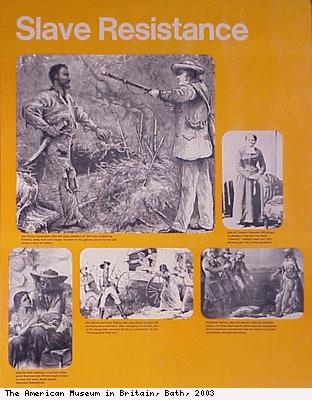
Description:
Poster: Slave Resistance .
Resistance means a refusal to comply (often secretively) with the established order or authority.
People who were slaves were sometimes known to resist their position, which was usually enforced.
Top left picture
Nat Turner surrenders, after his slave rebellion of 1831 was crushed by the Federal, state and local troops. He went to the gallows proud that he had struck a blow for liberty.
Top right picture
Harriet Tubman liberated 300 slaves in nineteen trips to the South. General Tubman lived until 1913, devoting her life to helping others.
Bottom left picture
Despite laws making it a serious crime, some people taught slaves to read and write. Some slaves educated themselves.
Bottom middle picture
Ann Wood and other fleeing teenage slaves frighten off pursuing slave-catchers. After escaping to Canada, one of the young men returned south as a conductor for the Underground Railroad .
Bottom right picture
Margaret Garner, who fled slavery with her children, tried to kill them and herself when she was recaptured. Slave resistance sometimes took the form of suicide, infanticide (killing of infants) and self-mutilation.
Contributed by John Judkyn Memorial.
Date: unknown
Copyright: The American Museum in Britain, Bath
Object ID:74.179.4
Abolitionism poster
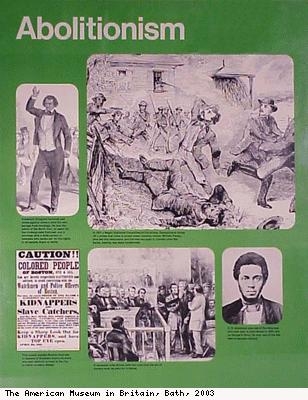
Description:
Poster: Abolitionism .
The word abolition
means to put an end to something. Abolition was the title given to the campaign to end the slave trade.
Top left picture
Frederick Douglass lectured and wrote against slavery after his own escape from bondage. He was the editor of the North Star, an agent for the Underground Railroad , and a reformer with a wide variety of interests who spoke out for the rights of all people, black or white.
Top right picture
In 1851 a Negro Vigilance Committee in Christiana, Pennsylvania drove off a posse that came to arrest some runaway slaves. William Parker, who led this resistance, and his men escaped to Canada after the battle leaving one dead slaveholder.
Bottom left picture
This poster warned Boston Negroes to beware of Southern slave-catchers who had recently arrived in the city to catch runaway slaves.
Bottom middle picture
A wounded John Brown tells the court that the sin of slavery must be paid for in blood.
Bottom right picture
O R Anderson was one of five black people who took part in John Browns raid on Harpers Ferry. He was one of the few men to escape capture.
Contributed by John Judkyn Memorial.
The language used to describe people of African descent in the 18th, 19th and 20th centuries is unacceptable in todays terms. We cannot avoid using this language in its original context. To change the words would impose 20th century attitudes on history.
Date: c1830s - 1850s
Copyright: The American Museum in Britain, Bath
Object ID:74.179.5
Inventors and Scientists Poster
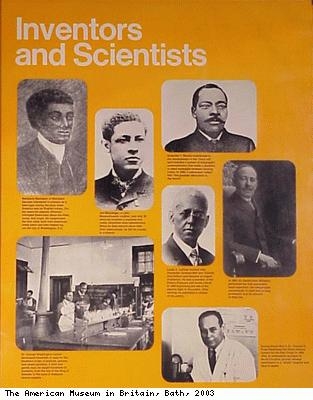
Description:
Poster: Inventors and Scientists .
Top left picture
Benjamin Banneker of Maryland USA became interested in science as a teenager during the days when America was an English colony. For ten years, his popular Almanac (annual publication)informed Americans about the tides, moon and crops. He constructed the first clock built from American-made parts and later helped lay out the city of Washington D.C.
Top middle picture
Lynn Matzeliger, a Lynn, Massachusetts cobbler, was only 30 when he invented a machine that vastly simplified shoe manufacture. When he died several years later from tuberculosis, he left his money to a church.
Top right picture
Granville T Woods contributed to the development of the third rail and invented a system of telegraphic communication that made it possible to send messages between moving trains. In 1888, a newspaper called him the greatest electrician in the world .
Middle left picture
Lewis H Latimer worked with Alexander Graham Bell and Thomas Alva Edison and became an expert draftsman. He was a member of the Edison Pioneers and wrote a book in 1890 explaining the use of the electric light to the public. After retiring, he published a volume of his poetry.
Middle middle picture
In 1893, Dr. Daniel Hale Williams performed the first successful heart operation. He campaigned successfully to open the nursing profession and its schools to black people.
Bottom left picture
Dr George Washington Carver developed hundreds of uses for the Southern crops of peanuts, pecans and sweet potatoes. A kind and gentle man, he taught hundreds of students, from the son of the King of Sweden to the sons of Alabama sharecroppers.
Bottom right picture
During World War II, Dr. Charles R Drew developed the blood plasma system for the Red Cross. In 1950, after an automobile accident in North Carolina, he was refused entry to a “white” hospital and bled to death.
Contributed by John Judkyn Memorial.
Date: 1800s - 1900s
Copyright: The American Museum in Britain, Bath
Object ID:74.179.6
Southern Reconstruction poster
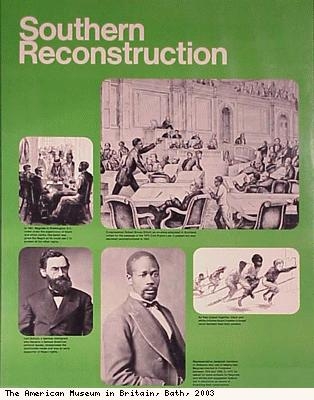
Description:
Poster: Southern Reconstruction .
Top left picture
In 1867, black people in Washington, DC voted under the supervision of black and white clerks. The ballot was given to the black people to protect their rights.
Top right picture
Congressman Robert Brown Elliott, an ex-slave educated in Scotland, called for the passage of the 1875 Civil Rights Law. It passed but was declared unconstitutional in 1883.
Bottom left picture
Carl Schurz, a German immigrant who became a famous American political leader, championed the abolitionist cause and was an early supporter for the rights of black people.
Bottom middle picture
Representative Jeremiah Haralson of Alabama was one of twenty two black people elected to Congress between 1870 and 1898. In 1875. He asked for more schools for Negroes and whites and suggested federal aid to education as a means of financing their construction.
Bottom right picture
As they played together, black and white children found it easier to break racial barriers than their parents.
Contributed by John Judkyn Memorial.
The language used to describe people of African descent in the 18th, 19th and 20th centuries is unacceptable in today’s terms. We cannot avoid using this language in its original context. To change the words would impose 20th century attitudes on history.
Date: c1860s - 1890s
Copyright: The American Museum in Britain, Bath
Object ID:74.179.7
World War II poster
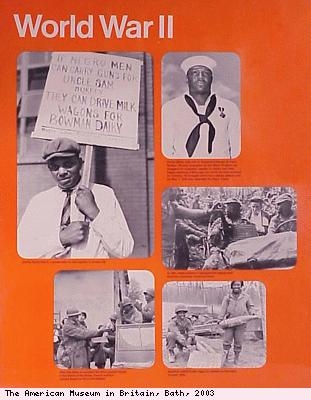
Description:
Poster: World War II.
Top left picture
During World War II a picket asks for job equality in civilian life.
Top right picture
Dorrie Miller was one of Americas heroes at Pearl Harbour. Boxing champion of the West Virginia, he dragged his wounded captain to safety and then began manning a Navy gun, for which he had received no training. He brought down four enemy planes and on May 7, 1942 was awarded the Navy Cross.
Middle right picture
In 1944, these soldiers in Bougainville (Solomon Islands, Papua New Guinea) helped push back the Japanese, island by island.
Bottom left picture
After the Allies drove back the Nazi counter-attack in the Battle of the Bulge, French soldiers reward GIs who helped.
Bottom right picture
Soldiers rolling Easter eggs for delivery to Germany in April, 1945.
Contributed by John Judkyn Memorial
Date: 1939 - 1945
Copyright: The American Museum in Britain, Bath
Object ID:74.179.9
World War I poster

Description:
Poster: World War I .
Top left picture
Colonel Charles Young, 10th Cavalry, was the highest ranking black officer in the United States Army ay the outbreak of World War I. In 1916, he served with John J Black Jack Pershing in the Mexican campaign against Pancho Villa.
Top middle picture
As the United States entered World War I in 1917, 15,000 black New Yorkers conducted a silent protest parade against the increasing number of anti-black riots and lynchings.
Top right picture
The 369th Infantry Regiment in the trenches in France April 4, 1918. Called the Harlem Hell Fighters , this division earned the French Croix de Guerre for bravery.
Bottom left picture
Returning to the United States aboard the US Roma, two GIs show how they captured Germans in the war.
Bottom right picture
Sergeant Henry Johnson (holding flowers) receiving a New York welcome. He and Private Needham Roberts wiped out a German raiding party of twenty.
Contributed by John Judkyn Memorial.
Date: 1914 - 1918
Copyright: The American Museum in Britain, Bath
Object ID:74.179.10
Pathfinders poster
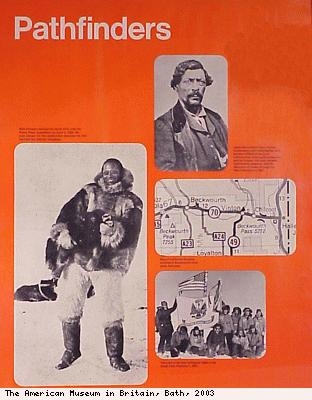
Description:
Poster: Pathfinders.
Bottom left picture
Matt Henson reached the North Pole with the Peary Polar expedition on April 6, 1909. He was chosen for the exploration because he had learned the Eskimo language.
Top right picture
James Beckwourth was a daring frontiersman and Indian fighter who became a Chief of the Crow Indians, Army scout, gold prospector and fur trapper. His most valuable contribution, however, was the discovery of a pass through the Sierra Nevadas in 1850.
Middle right picture
Map of California showing location of Beckwourth town, peak and pass.
Bottom right picture
Crew of the first helicopter flight to the South Pole, February 4, 1963.
Contributed by John Judkyn Memorial.
Date: 1800s
Copyright: The American Museum in Britain, Bath
Object ID:74.179.12
20th Century Writers poster
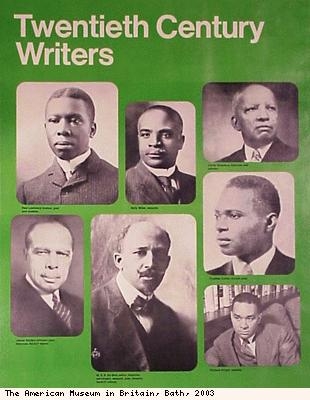
Description:
20th Century Writers poster.
A poster showing black writers of the 20th century.
Top left picture; Paul Lawrence Dunbar, poet and novelist.
Top middle picture; Kelly Miller, essayist.
Top right picture; Carter Woodson, historian and scholar.
Bottom left picture; James Weldon Johnson, poet, historian, NAACP leader – National Association for the Advancement of Colored People.
Bottom middle picture; WEB Du Bois, editor, historian, sociologist, essayist, poet, novelist, NAACP official.
Middle right picture; Countee Cullen, Harlem poet.
Bottom right picture; Richard Wright, novelist.
Contributed by John Judkyn Memorial.
Date: 20th century
Copyright: The American Museum in Britain, Bath
Object ID:74.179.13
Civil Rights crisis poster
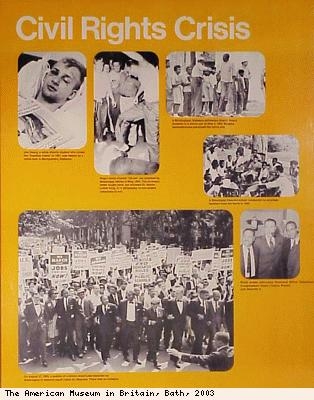
Description:
Civil Rights Crisis poster.
Top left picture
Jim Zwerg, a white divinity student who joined the freedom riders in 1961, was beaten by a white mob in Montgomery, Alabama.
Top middle picture
Black lunch-counter sit-ins are attacked by Mississippi whites in May, 1963. The sit-inners never fought back, but followed Dr Martin Luther King Jnrs philosophy of non-violet resistance to evil.
Top right picture
A Birmingham, Alabama policeman directs black students to a police van on May 6, 1963. Massive demonstrations paralysed the entire city.
Middle right picture
A Mississippi freedom school conducted by volunteer teachers from the North in 1964.
Bottom left picture
On August 27, 1963, a quarter of a million Americans marched on Washington to demand equal rights for black people. There was no violence.
Bottom right picture
Black power advocates Reverend Milton Galamison, Congressman Adam Clayton Powell and Malcolm X.
Contributed by John Judkyn Memorial.
Date: c1960s
Copyright: The American Museum in Britain, Bath
Object ID:74.179.15
Receipt for whipping
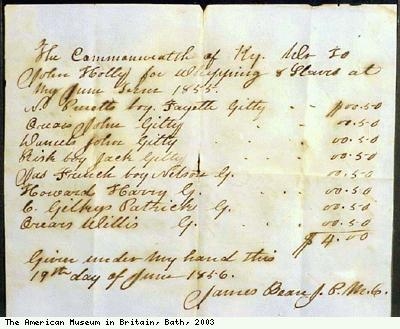
Description:
Receipt for whipping eight slaves, dated 19th June 1856. $4.00 paid to John Holly – 50 cents fee for whipping each slave.
Contributed by John Judkyn Memorial.
Date: 19th June 1856
Copyright: The American Museum in Britain, Bath
Object ID:74.195
Page 323 of 352 pages « First < 321 322 323 324 325 > Last »

